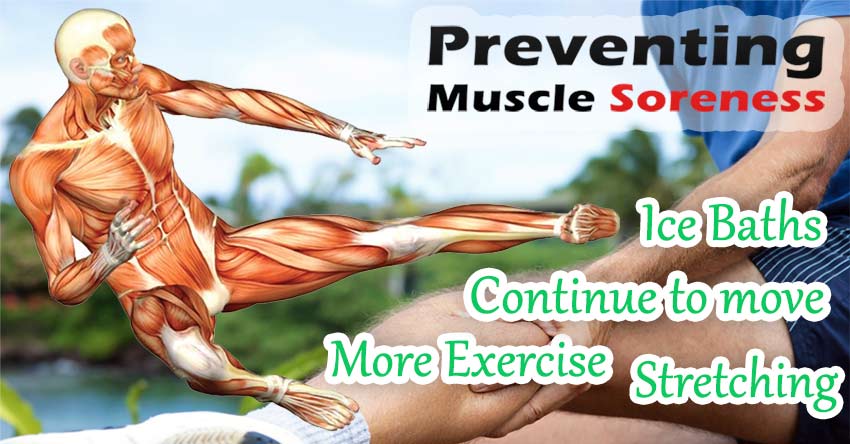How to prevent the delayed onset of muscle soreness, otherwise known as DOMS.

The delayed onset of muscle soreness, or DOMS as it’s known for short describes a phenomenon of muscle soreness or muscle stiffness that happens around a day or so after exercise. It’s most often felt at the start of a new exercise program, a change of routine or when you dramatically increase the duration or intensity of your existing routine. Although for those new to working out, it can be somewhat alarming, the delayed onset of muscle soreness is actually a normal response to different or unusual exertion. It’s a part of the adapting process that leads to the body achieving greater stamina and strength. The muscles recover and build hypertrophy; for those who might not be aware, hypertrophy is the enlargement of an organ or tissue when its cells increase in size.
DOMS is not the same sort of muscle pain that you would normally experience during exercise, nor is it like the sudden, sharp or acute pain that you would naturally feel as the result of an injury such as a strain or sprain. The delayed muscle soreness that’s associated with DOMS is generally at its worst within the first couple of days following a new activity. It does however eventually subside after a few days.
So what exactly is it that causes muscles soreness after we exercise? Well it’s thought that DOMS is actually a result of microscopic tearing of the muscles fibers. Of course the amount of tearing depends on how hard and how long you push yourself during exercise and the type of exercise you do. This then relates directly to the severity of DOMS you would experience. Absolutely any movement that you aren’t used to can lead to DOMS however movements that would cause the muscle to forcefully contract while it lengthens seems to cause more soreness. This movement is known as eccentric muscle contractions and examples of these would be going down stairs and the downward motion of push-ups. Eccentric muscle contractions could also lead to swelling in a muscle as well as small tears; this would obviously contribute to soreness.
There are ways however that you can reduce the delayed onset of muscle soreness and that’s by helping your muscles to repair as quickly as possible. This can be achieved by delivering all the required nutrients to the muscle as quickly as possible and this can be done in a variety of ways. Here are just some strategies that we suggest here at City Rehab Sports Physiotherapy Centre.
Stretching
Stretching can help prevent tightness in the muscles that you’ve used. Doing this after exercise is very important when it comes to reducing the chances of any injuries too.
Ice Baths
You may have heard of this and brushed it off as mad; athletes jumping into ice baths in training. Well there is actually method in their madness as a cold bath after you work out can narrow the blood vessels in the muscles, which leads to the blood being pushed back to the heart. When this happens, metabolites are cleared from the muscle.
When you jump out of the bath your vessels quickly dilate and allow the blood back to the muscle in an attempt to warm it up. This sudden influx of blood brings with it fresh nutrients that your muscles will be only too happy to use in order to repair. This then accelerates the recovery. When doing this it’s important to remember that you must gradually increase the duration of being submerged and gradually reduce the temperature too. This will prevent any adverse reactions. You should submerge your body, preferably in a standing position for no more than ten minutes.
Continue to move
A huge mistake that people seem to make is to sit down and stop moving. Yes we realise that sitting can’t always be avoided, especially if you have a nine to five office job however some movement is imperative. This is especially the case for the muscles you used during exercise. The reason for this is that without movement, blood flow is naturally reduced.
This decreases its access to vital nutrients that are needed to speed up recovery. As you can imagine this would naturally increase recovery time. The other reason for movement is that the body will begin to repair the micro tears in the static position they’re in. This means the fibers will adapt their length to suit this position, which would lead to tightness and some imbalance.
More Exercise
Simply put the more you exercise, the more your body will adapt to the strains you put on it. Your muscles will grow and become stronger, which will increase their threshold for micro damage. Your cardiovascular system will also become better at providing nutrients to the muscles through increased red blood cells and a much stronger heart and lungs; this will all reduce the recovery time. It’s also worth remembering too that the more you exercise, you more aware you’ll become of which strategies work best for you i.e. exercise, ice baths etc.
In spite of all these strategies, if you train hard you will indeed experience DOMS, which can in some cases negatively affect your training regime. If you’d like more advice on how to reduce DOMS or how best to deal with the onset of it, an appointment with one of our qualified physiotherapists may help.

